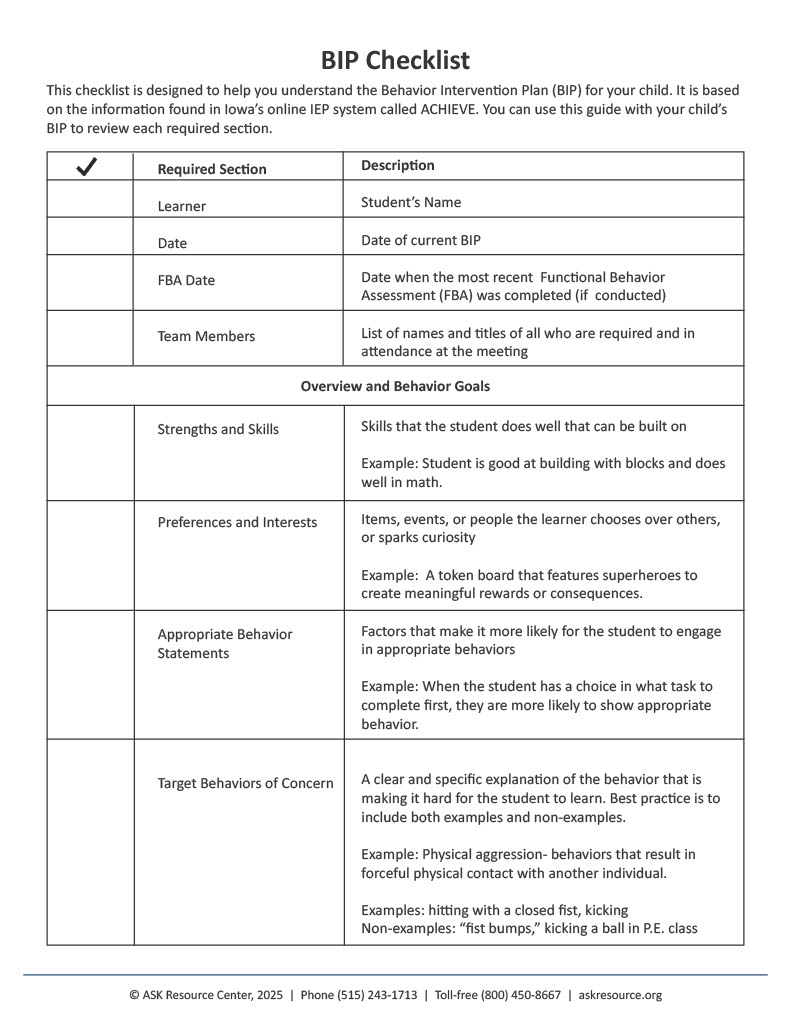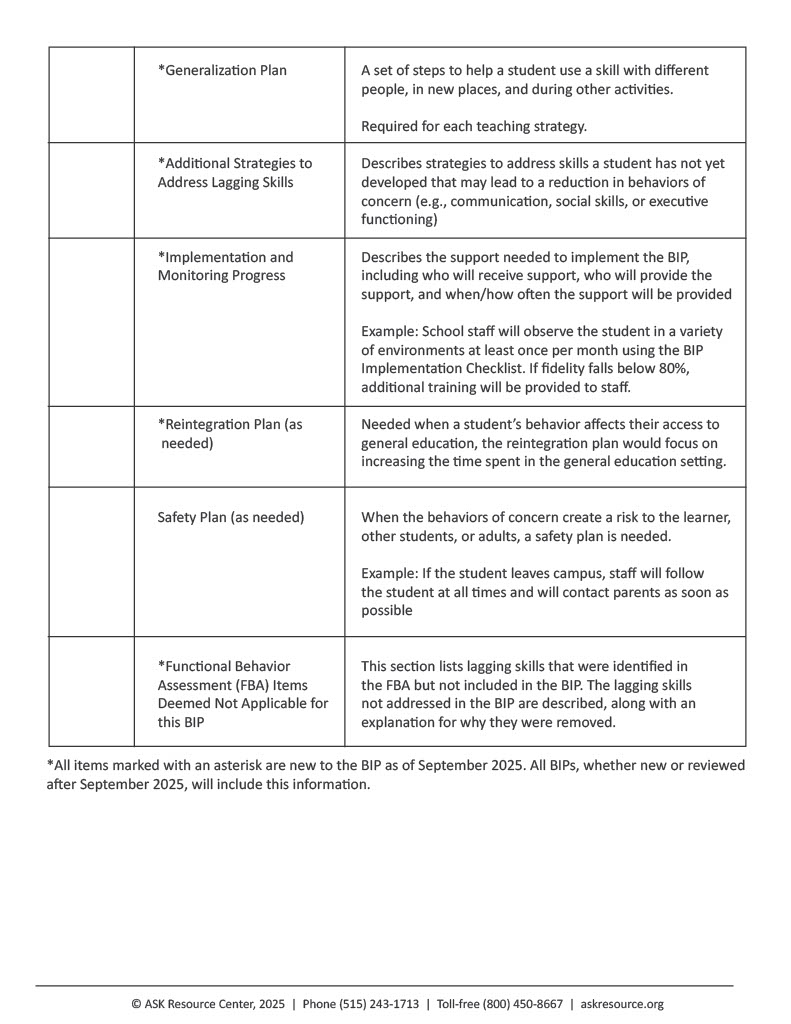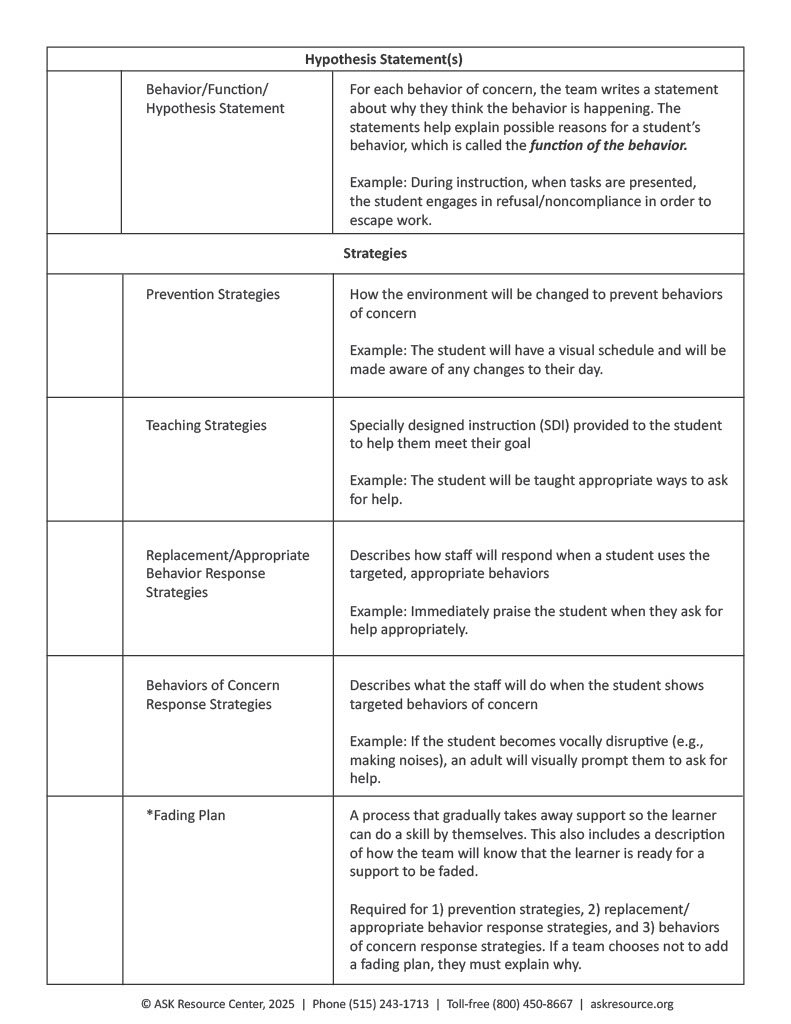Print the PDF
Updated 11/17/2025
Behavior Intervention Plan (BIP)
Guide and Checklist
What is a Behavior Intervention Plan?
A Behavior Intervention Plan (BIP) is a detailed document that lists specific strategies to help prevent and respond to challenging behavior. It is personalized for each student to make sure they have the support they need.
The BIP serves as a guide for teachers, caregivers, and other people working with the student. When adults follow a BIP consistently, they respond to the student’s actions in the same way across different settings. This helps the student know what to expect throughout the day.
The BIP should also list specific behaviors that the student will be taught to replace the challenging behavior. This instruction helps the student learn better ways to communicate their needs.
When is a BIP needed?
According to Iowa IDEA Information (i3),
- A BIP may be created for any student who has behaviors that are interfering with their learning or the learning of others. This could be for any student, with or without an IEP or 504 Plan.
- A BIP must be completed, or reviewed, for any child with an IEP who is removed from their regular setting because of behavior for:
- more than 10 days in a row; or
- more than 10 school days in a school year for separate, similar incidents that show a pattern
- AND a manifestation determination meeting has been held, and the team decided that the behavior was caused by or related to the child’s disability.
How is a BIP created?
When a BIP is created by an IEP team, it is best practice to use the results of a Functional Behavior Assessment (FBA). Understanding the reason or function for a student’s behavior can help the team come up with ways to prevent and consistently respond. The BIP also includes how to teach new and positive behaviors instead of challenging ones. All strategies are tailored to the individual student’s needs.
Who is involved in creating the BIP?
A member of the school team or Area Education Agency (AEA) who has experience and training in writing BIPs leads this process. This person could be a school psychologist, a school social worker, a special education consultant, a member of a behavior team, or a special education teacher.
Parents also play an important role in the BIP process. Their knowledge about their child is valuable when creating a consistent plan. Parents can provide insight on what has been tried in the past and what strategies work or don’t work at home. They can also share recommendations from a therapist or other outside providers.
What if I have concerns that my child’s BIP is not working?
When a BIP is first started, the student’s behavior may get worse before it improves. This can happen when they are learning their new plan. If the BIP has been followed for several weeks and the data does not show improvement, the team, including parents, could meet to discuss these questions developed by Kristi Miiller, Grant Wood AEA Behavior Consultant.
In conclusion, when a BIP is successful, it effectively supports students, teachers, and parents, allowing them to focus less on behavior and more on the student’s learning.
Related Resources:
Search these titles at www.askresource.org/resources
- Functional Behavior Assessment (FBA) Guide and Checklist
- Challenging Behavior in School
- The ABCs of Challenging Behavior
- Removal of Students with Disabilities from School
- Progress Monitoring
ASK Essential Questions:
- What interventions have been tried to address my student’s behaviors of concern?
- Do the strategies in the BIP match the functions of behavior identified in the FBA?
- Is the team using the BIP Implementation Checklist to ensure the plan is being followed?
- How will the team communicate?
References:
Iowa IDEA Information (i3). “Three Situations an IEP Team Develops a BIP. https://iowaideainformation.org/special-education/individualized-education-programs/behavior-in-an-iep/
Iowa Department of Education. (2025, September 17). Changes to functional behavior assessments and behavior intervention plans in ACHIEVE [Video]. YouTube. https://youtu.be/pDyc4yLMyso
Miiller, K. (May 3, 2025). What to Do When the BIP Isn’t Working. https://youtu.be/Ap4Ym-jfXcA?si=LuxUmNtfTgqhbdsx
BIP Checklist
Available within the PDF button at the top of this page.


